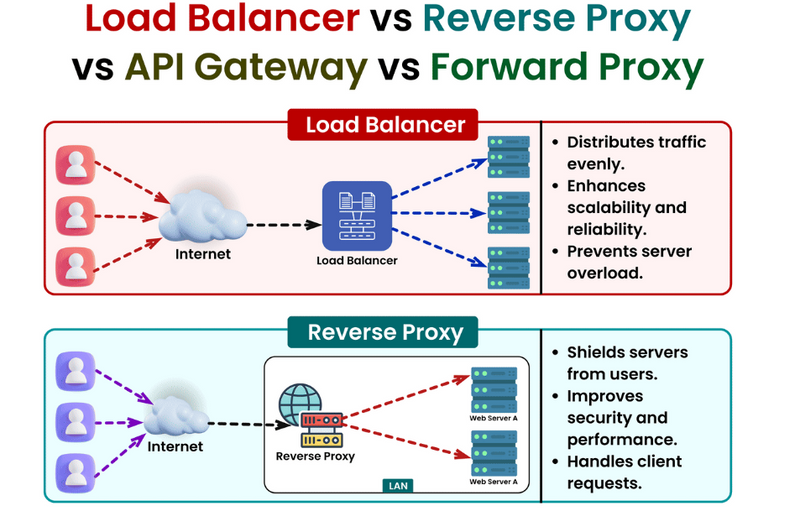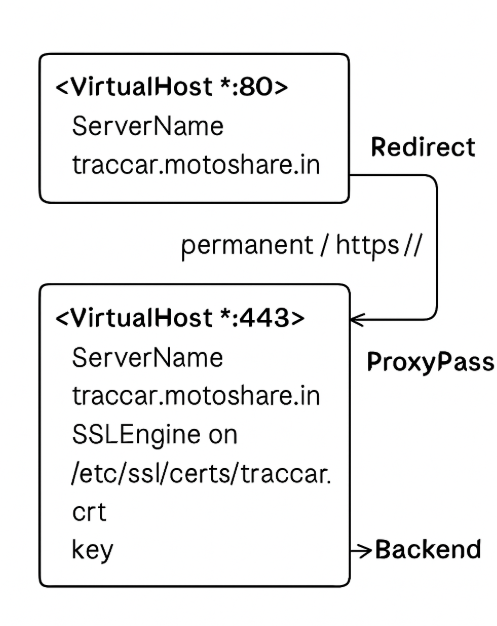Key Functions of a Proxy
When to Use a Reverse Proxy
Request Forwarding
Difference between Difference Between ProxyPass and ProxyPassReverse
How to redirect HTTP traffic to HTTPS and then forwards secure HTTPS requests to the Traccar service running on port 8082
How to redirects HTTP to HTTPS and proxies requests to different front-end services (React, Vue, Angular) while using a shared backend API
Troubleshoot
A proxy is an intermediary server that sits between a client (such as a browser or a user device) and a destination server (such as a web server or API). The proxy receives requests from the client, forwards them to the destination server, and then returns the server's response to the client.
Key Functions of a Proxy
Request Forwarding: A proxy server forwards the client’s request to the destination server.
Response Handling: After the destination server processes the request, the proxy server forwards the response back to the client.
Interception and Control: It can inspect, filter, modify, or cache the requests and responses, giving it the ability to modify content, log requests, or block malicious traffic.
When to Use a Reverse Proxy
A reverse proxy can be used in various scenarios:
Load Balancing: Distribute incoming traffic across multiple backend servers.
Security: Protect backend servers by hiding their identity from the client.
Caching: Cache content to reduce the load on backend servers and improve performance.
SSL Termination: Handle SSL/TLS encryption/decryption on behalf of the backend servers.
API Gateway: Aggregate and route API requests from clients to different microservices.
Content Filtering: Inspect incoming and outgoing requests to enforce security policies.
Request Forwarding
Run the following commands to enable the modules:
sudo a2enmod proxy
sudo a2enmod proxy_http
Redirect Traffic Based on IP Address to Different Ports
# /etc/httpd/conf/httpd.conf or /etc/apache2/sites-available/000-default.conf
<VirtualHost *:80>
ServerName example.com
ProxyPass / http://localhost:3000/
ProxyPassReverse / http://localhost:3000/
</VirtualHost>
This configuration forwards all incoming requests to the backend server running on localhost:3000 (e.g., Node.js server).
For example, let’s say you have multiple services running on the same server:
Service 1: Running on port 8081 (e.g., a web application)
Service 2: Running on port 8082 (e.g., a REST API)
You can configure Apache to redirect traffic to these different services based on the requested URL or conditions.
Define the Reverse Proxy Settings
<VirtualHost *:80>
ServerName example.com
DocumentRoot /var/www/html
# Enable mod_rewrite for URL rewriting (if necessary)
RewriteEngine On
# Reverse Proxy for Service 1 (on port 8081)
ProxyPass "/service1" "http://localhost:8081"
ProxyPassReverse "/service1" "http://localhost:8081"
# Reverse Proxy for Service 2 (on port 8082)
ProxyPass "/service2" "http://localhost:8082"
ProxyPassReverse "/service2" "http://localhost:8082"
# Log Settings
ErrorLog ${APACHE_LOG_DIR}/error.log
CustomLog ${APACHE_LOG_DIR}/access.log combined
</VirtualHost>
curl http://example.com/service1
Redirecting Traffic to Another Server's IP Address Using Apache Reverse Proxy
<VirtualHost *:80>
ServerName yourdomain.com
# Document root for your website (can be different)
DocumentRoot /var/www/html
# Enable mod_rewrite (optional, if needed)
RewriteEngine On
# Proxy pass for service1, redirecting to another server's IP address
ProxyPass "/service1" "http://192.168.1.100:8080"
ProxyPassReverse "/service1" "http://192.168.1.100:8080"
# Custom log settings
ErrorLog ${APACHE_LOG_DIR}/error.log
CustomLog ${APACHE_LOG_DIR}/access.log combined
</VirtualHost>
<VirtualHost *:80>
ServerName yourdomain.com
# Service 1 (forward to backend server 1)
ProxyPass "/service1" "http://192.168.1.100:8080"
ProxyPassReverse "/service1" "http://192.168.1.100:8080"
# Service 2 (forward to backend server 2)
ProxyPass "/service2" "http://192.168.1.101:8080"
ProxyPassReverse "/service2" "http://192.168.1.101:8080"
# Log settings
ErrorLog ${APACHE_LOG_DIR}/error.log
CustomLog ${APACHE_LOG_DIR}/access.log combined
</VirtualHost>
redirect to domain name
If you want to set up Apache as a reverse proxy to redirect traffic to different domains instead of specific IP addresses, you can modify the ProxyPass and ProxyPassReverse directives to forward the requests to different domains that are hosted on different servers.
In this case, you'll replace the IP addresses in the ProxyPass and ProxyPassReverse directives with the domain names of the backend servers
<VirtualHost *:80>
ServerName yourdomain.com
# Service 1 (forward to backend server 1 with domain)
ProxyPass "/service1" "http://backend1.example.com"
ProxyPassReverse "/service1" "http://backend1.example.com"
# Service 2 (forward to backend server 2 with domain)
ProxyPass "/service2" "http://backend2.example.com"
ProxyPassReverse "/service2" "http://backend2.example.com"
# Log settings
ErrorLog ${APACHE_LOG_DIR}/error.log
CustomLog ${APACHE_LOG_DIR}/access.log combined
</VirtualHost>
You have:
configuration of multiple front end sharing same backend on same server
Multiple React frontend projects (one for each service, e.g. /users, /orders)
A single Laravel backend API
An Apache reverse proxy to route frontend and API requests
<VirtualHost *:80>
ServerName api.example.com
# React frontends
ProxyPass /users http://localhost:3001/
ProxyPassReverse /users http://localhost:3001/
ProxyPass /orders http://localhost:3002/
ProxyPassReverse /orders http://localhost:3002/
# Backend API
ProxyPass /api http://localhost:8000/api
ProxyPassReverse /api http://localhost:8000/api
ProxyPass /sanctum http://localhost:8000/sanctum
ProxyPassReverse /sanctum http://localhost:8000/sanctum
</VirtualHost>
Load Balancing
A reverse proxy can distribute incoming requests to different backend servers to ensure no single server is overwhelmed, improving the system’s scalability and availability.
Example:
Apache as a reverse proxy with load balancing:
# /etc/httpd/conf/httpd.conf or /etc/apache2/sites-available/000-default.conf
<VirtualHost *:80>
ServerName example.com
# Enable Load Balancing using mod_proxy
<Proxy "balancer://mycluster">
BalancerMember http://192.168.1.1:8080
BalancerMember http://192.168.1.2:8080
ProxySet lbmethod=byrequests
</Proxy>
# Forward requests to the load balancer
ProxyPass / balancer://mycluster/
ProxyPassReverse / balancer://mycluster/
</VirtualHost>
In this example, Apache forwards all incoming traffic to two backend servers (192.168.1.1:8080 and 192.168.1.2:8080) and balances the load between them.
API Gateway in Microservices Architecture with Load Balancer
<VirtualHost *:80>
ServerName api.example.com
# Load balancing for user authentication service
<Proxy "balancer://auth-service">
BalancerMember http://192.168.1.1:8081
BalancerMember http://192.168.1.2:8081
ProxySet lbmethod=byrequests
</Proxy>
# Load balancing for payment processing service
<Proxy "balancer://payment-service">
BalancerMember http://192.168.1.1:8082
BalancerMember http://192.168.1.2:8082
ProxySet lbmethod=byrequests
</Proxy>
# Load balancing for order management service
<Proxy "balancer://order-service">
BalancerMember http://192.168.1.1:8083
BalancerMember http://192.168.1.2:8083
ProxySet lbmethod=byrequests
</Proxy>
# Load balancing for inventory service
<Proxy "balancer://inventory-service">
BalancerMember http://192.168.1.1:8084
BalancerMember http://192.168.1.2:8084
ProxySet lbmethod=byrequests
</Proxy>
# Route requests based on URL path
ProxyPass "/auth" balancer://auth-service/
ProxyPassReverse "/auth" balancer://auth-service/
ProxyPass "/pay" balancer://payment-service/
ProxyPassReverse "/pay" balancer://payment-service/
ProxyPass "/order" balancer://order-service/
ProxyPassReverse "/order" balancer://order-service/
ProxyPass "/inventory" balancer://inventory-service/
ProxyPassReverse "/inventory" balancer://inventory-service/
</VirtualHost>
Security/Access Control
A reverse proxy can help protect backend servers by hiding them behind the proxy. It can also enforce security policies such as IP filtering or rate limiting.
Example:
Restrict access to the backend server to specific IP addresses:
# /etc/apache2/sites-available/000-default.conf
<VirtualHost *:80>
ServerName example.com
# Restrict access to the backend server
<Location />
Order Deny,Allow
Deny from all
Allow from 192.168.1.100
Allow from 192.168.1.101
</Location>
# Proxy to the backend server
ProxyPass / http://localhost:8080/
ProxyPassReverse / http://localhost:8080/
</VirtualHost>
In this case, only IP addresses 192.168.1.100 and 192.168.1.101 are allowed to access the backend server at localhost:8080.
SSL Termination
A reverse proxy can handle SSL/TLS encryption on behalf of backend servers, allowing the backend servers to focus on processing requests. This is called SSL Termination.
Example:
Enable SSL termination on Apache:
# /etc/apache2/sites-available/default-ssl.conf
<VirtualHost *:443>
ServerName example.com
# Enable SSL
SSLEngine on
SSLCertificateFile /etc/ssl/certs/example_com.crt
SSLCertificateKeyFile /etc/ssl/private/example_com.key
# Proxy requests to backend server
ProxyPass / http://localhost:8080/
ProxyPassReverse / http://localhost:8080/
</VirtualHost>
This configuration terminates SSL at the proxy server, so the backend server communicates over HTTP (not HTTPS). It reduces the overhead of managing SSL certificates on multiple backend servers.
Caching
Reverse proxies can cache responses from backend servers, which reduces the load on the backend and improves the speed of content delivery.
Example:
Enable caching in Apache using mod_cache:
# /etc/apache2/sites-available/000-default.conf
<VirtualHost *:80>
ServerName example.com
# Enable caching
CacheEnable disk /
CacheRoot /var/cache/apache2
# Proxy to backend server
ProxyPass / http://localhost:8080/
ProxyPassReverse / http://localhost:8080/
# Set caching duration
CacheDefaultExpire 600
CacheMaxExpire 86400
</VirtualHost>
This caches the responses for 10 minutes (CacheDefaultExpire 600), reducing the backend server load and speeding up content delivery for subsequent requests.
API Gateway (Microservices Architecture)
In a microservices architecture, a reverse proxy can act as an API gateway that routes client requests to appropriate microservices.
Example:
A reverse proxy to route API requests to different services:
# /etc/apache2/sites-available/api-gateway.conf
<VirtualHost *:80>
ServerName api.example.com
# Route to user service
ProxyPass /users http://user-service:3000/
ProxyPassReverse /users http://user-service:3000/
# Route to order service
ProxyPass /orders http://order-service:4000/
ProxyPassReverse /orders http://order-service:4000/
</VirtualHost>
In this example, the reverse proxy routes requests to different microservices (/users to the user-service and /orders to the order-service).
Difference between Difference Between ProxyPass and ProxyPassReverse
ProxyPass and ProxyPassReverse are both crucial directives used when setting up Apache as a reverse proxy, but they serve distinct purposes:
ProxyPass: Forwards requests from clients to a backend server. It tells Apache how and where to send inbound web requests.
ProxyPassReverse: Rewrites HTTP response headers (specifically Location and Content-Location) from the backend so that redirects and links sent back to the client point to the proxy server, not the backend’s internal address.
In essence:
ProxyPass controls request forwarding (client → Apache → backend).
ProxyPassReverse controls response header rewriting (backend → Apache adjusts URLs → client), making the user experience seamless and masking backend technology and URLs.
Unique Examples
Basic Reverse Proxying a Web Application
ProxyPass /app http://localhost:8080/
ProxyPassReverse /app http://localhost:8080/
ProxyPass: Forwards all requests from /app to your local application.
ProxyPassReverse: Ensures backend redirects (e.g., Location: http://localhost:8080/login) are rewritten to /app/login for the user.
Proxying with a Remote Backend Server
ProxyPass / http://192.168.1.100:8081/
ProxyPassReverse / http://192.168.1.100:8081/
Users visiting your proxy see your domain, not the backend’s private IP.
Backend redirects like Location: http://192.168.1.100:8081/foo appear as your domain’s equivalent URL to the client.
Path Mapping Between Proxy and Backend
ProxyPass /service http://my-backend:9000/api/
ProxyPassReverse /service http://my-backend:9000/api/
URLs like /service/users are actually served from /api/users on the backend.
If backend responds with a redirect to http://my-backend:9000/api/login, ProxyPassReverse rewrites it to /service/login.
Proxy for a Jenkins Instance with Path Translation
ProxyPass /jenkins http://localhost:8081/jenkins nocanon
ProxyPassReverse /jenkins http://localhost:8081/jenkins
All /jenkins requests are handled by your Jenkins server on a different port.
Jenkins redirects (such as for login) will keep the frontend path /jenkins visible to the user instead of exposing the backend host or port.
Using ProxyPassReverse for Cookie Domains
ProxyPass /mail http://mail.internal:8888/
ProxyPassReverse /mail http://mail.internal:8888/
ProxyPassReverseCookieDomain mail.internal yourdomain.com
reverse-proxy
load-balancer-vs-reverse-proxy-vs-forward-proxy-vs-api-gateway
HTTP traffic is redirected to HTTPS and then forwards secure HTTPS requests to the Traccar service running on port 8082
read for proxy
/opt/lampp/etc/extra/httpd-vhosts.conf
<VirtualHost *:80>
ServerName traccar.motoshare.in
Redirect permanent / https://traccar.motoshare.in/
</VirtualHost>
/opt/lampp/etc/extra/httpd-ssl.conf
<VirtualHost *:443>
ServerName traccar.motoshare.in
SSLEngine On
SSLCertificateFile "/opt/lampp/etc/certs/traccar.motoshare.in/traccar.motoshare.in.cer"
SSLCertificateKeyFile "/opt/lampp/etc/certs/traccar.motoshare.in/traccar.motoshare.in.key"
SSLCACertificateFile "/opt/lampp/etc/certs/traccar.motoshare.in/fullchain.cer"
ProxyPreserveHost On
ProxyPass / http://localhost:8082/
ProxyPassReverse / http://localhost:8082/
</VirtualHost>
How to redirects HTTP to HTTPS and proxies requests to different front-end services (React, Vue, Angular) while using a shared backend API
<VirtualHost *:80>
ServerName myapp.mydomain.com
# Redirect HTTP to HTTPS
Redirect permanent / https://myapp.mydomain.com/
</VirtualHost>
<VirtualHost *:443>
ServerName myapp.mydomain.com
# SSL Configuration
SSLEngine On
SSLCertificateFile "/etc/ssl/certs/myapp.mydomain.com.crt"
SSLCertificateKeyFile "/etc/ssl/private/myapp.mydomain.com.key"
SSLCACertificateFile "/etc/ssl/certs/myapp.mydomain.com.chain.pem"
# Proxying React service running on port 3000
ProxyPass /react http://localhost:3000/
ProxyPassReverse /react http://localhost:3000/
# Proxying Vue service running on port 8081
ProxyPass /vue http://localhost:8081/
ProxyPassReverse /vue http://localhost:8081/
# Proxying Angular service running on port 4200
ProxyPass /angular http://localhost:4200/
ProxyPassReverse /angular http://localhost:4200/
# Laravel Backend API (assuming it's running on port 8000)
ProxyPass /api http://localhost:8000/api
ProxyPassReverse /api http://localhost:8000/api
# Optional: Serve static content or assets for React/Vue/Angular if necessary
Alias /react/static /var/www/myapp/react/static
Alias /vue/static /var/www/myapp/vue/static
Alias /angular/static /var/www/myapp/angular/static
<Directory "/var/www/myapp/react/static">
Options Indexes FollowSymLinks
AllowOverride None
Require all granted
</Directory>
<Directory "/var/www/myapp/vue/static">
Options Indexes FollowSymLinks
AllowOverride None
Require all granted
</Directory>
<Directory "/var/www/myapp/angular/static">
Options Indexes FollowSymLinks
AllowOverride None
Require all granted
</Directory>
</VirtualHost>
--------OR---------------------------------
<VirtualHost *:443>
ServerName yourdomain.com
ServerAlias www.yourdomain.com
SSLEngine on
SSLCertificateFile /etc/ssl/certs/your_cert.crt
SSLCertificateKeyFile /etc/ssl/private/your_key.key
# Ensure these modules are loaded
ProxyPreserveHost On
# Proxy /react to React app (port 3000)
ProxyPass /react http://localhost:3000/
ProxyPassReverse /react http://localhost:3000/
# Proxy /vue to Vue app (port 4000)
ProxyPass /vue http://localhost:4000/
ProxyPassReverse /vue http://localhost:4000/
# Proxy /angular to Angular app (port 5000)
ProxyPass /angular http://localhost:5000/
ProxyPassReverse /angular http://localhost:5000/
# Proxy /api to backend API (port 8000) - shared for all
ProxyPass /api http://localhost:8000/api
ProxyPassReverse /api http://localhost:8000/api
# Optional: Static root to one of the frontends
ProxyPass / http://localhost:3000/
ProxyPassReverse / http://localhost:3000/
</VirtualHost>
Troubleshoot
custom-error-handling-and-indexing-in-apache-http-server
sudo tail -f /opt/lampp/logs/access_log
tail -f storage/logs/laravel.log
tail -f /opt/traccar/logs/tracker-server.log











Top comments (0)